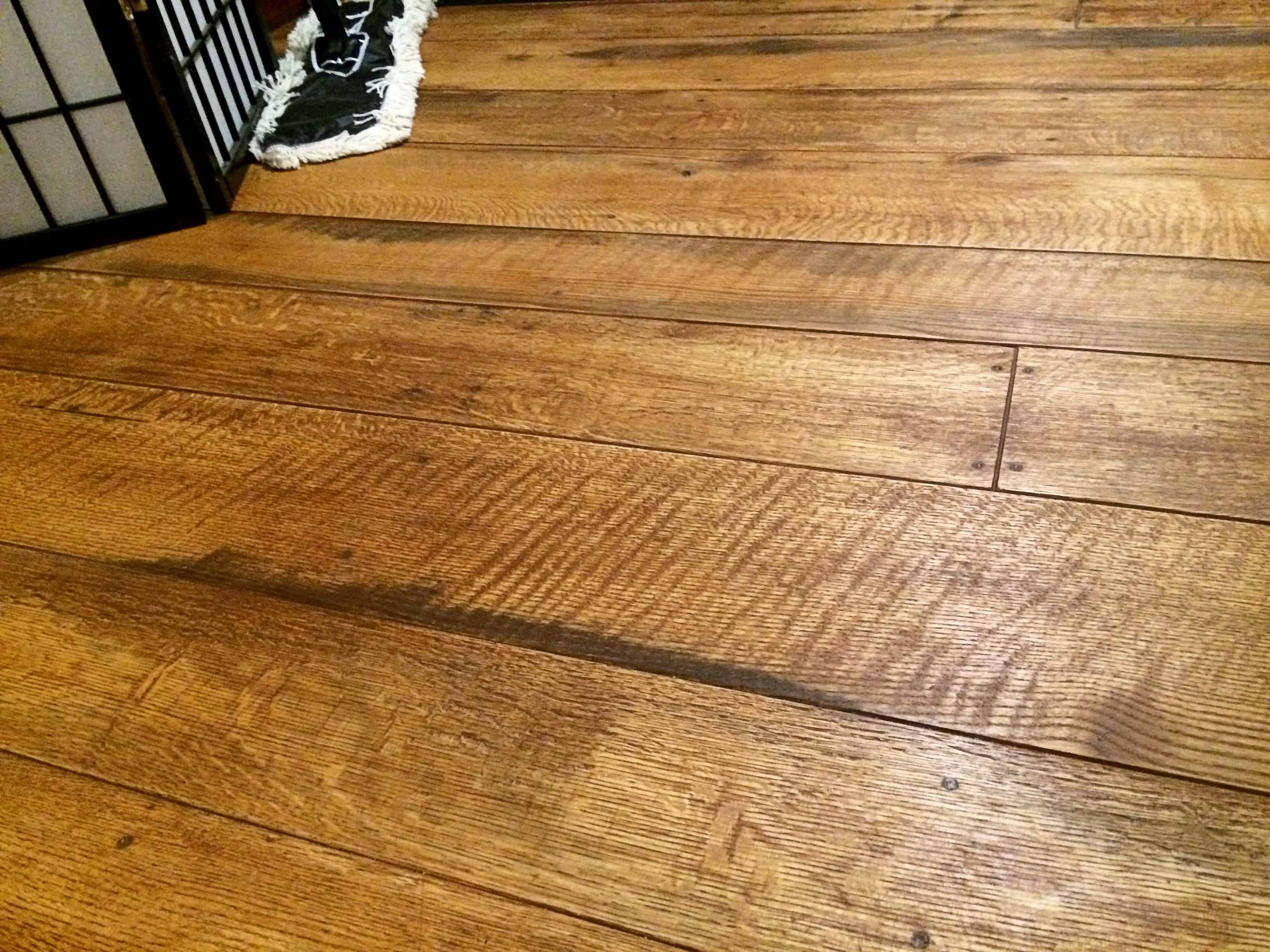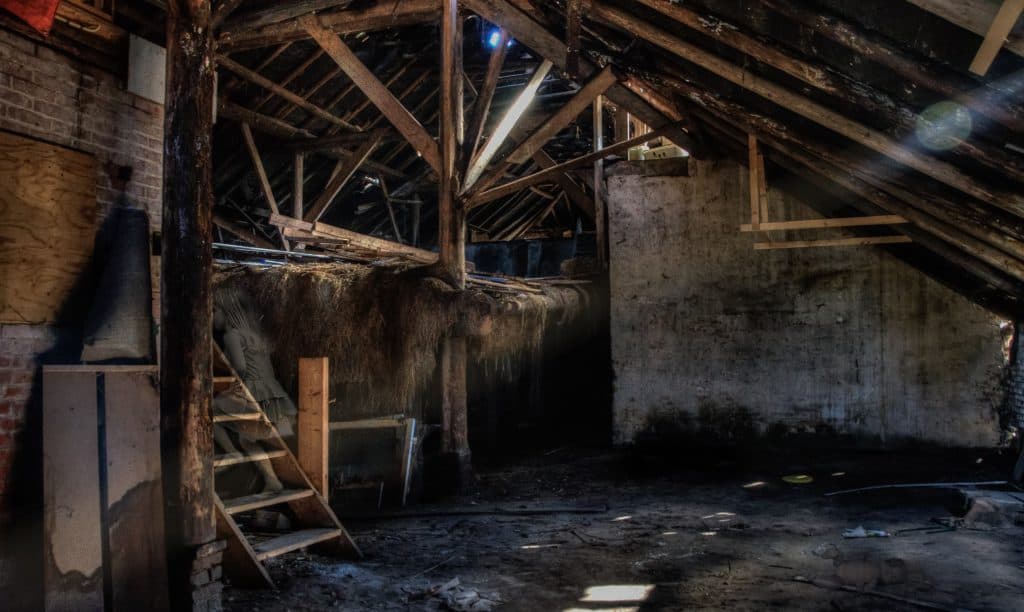Reclaimed Wood in Los Angeles Has One Huge Problem
Reclaimed wood has likely been exposed to excessive moisture over the years, resulting in mold and mildew. Mold and mildew can lead to serious respiratory problems, especially in children, the elderly, and those who suffer from asthma

Technical Information
- Scientific name: none
- Alternative Names: salvaged wood, reclaimed lumber, recycled wood, recycled lumber, recycled forest products
- Region of Origin: Anywhere
- Average Dried Weight: varies
- Janka Hardness Rating: varies
- Specific Gravity: varies
- IUCN Red List: sometimes
- CITES wood: sometimes
Reclaimed Wood’s Definition is Too Vague
Surprisingly, any wood product that is used for something other than its intended use is reclaimed. Accordingly, a wide range of woods comprise the reclaimed lumber market.
Most homeowners lack the knowledge to distinguish reclaimed wood beams from new hand hewn beams or rough sawn beams. In fact, most woodworkers cannot accurately distinguish reclaimed wood beams from newer distressed wood beams.
Additionally, no governing body created, approved or reviewed this definition. Unfortunately, consumers wrongly assume that reclaimed wood is a well defined product category.
For example, assume a wood supplier markets a 4/4 Red Oak board with 10 open knots as FAS grade lumber, A buyer’s quick visual inspection alerts her to the lumber grade issue. If the buyer and seller disagree on grade, they defer to the National Hardwood Lumber Association‘s uniform grading rules to settle the matter.
Similarly, the NHLA helps when there is a lumber specie discrepancy. For example, if a lumber buyer orders 4/4 Hickory lumber but receives 4/4 Pecan, the NHLA has guideline for consumer recourse.
Salvaged Lumber Essentially Has No Rules
Salvaged wood has no such rules or oversight association. As it stands, the generally accepted definition allows the marketing of a wide range of items as reclaimed.
Critical Questions About Reclaimed Forest Products
- What if a seller just slaps a “reclaim” label on an item that isn’t?
- How does a buyer verify a salvaged wood product back story?
- What recourse does a seller have if she finds out she’s bought fake reclaimed?
If you know the answer to any of these questions, please let me know, I’m a hardwood distributor with 25 years of lumber industry experience and I have no clue!
Why is no one talking about this?
The reason no one discusses this serious issue is that everyone has a vested interest in maintaining the integrity of a reclaimed wood.
- Sellers are motivated by higher margins associated with reclaimed lumber sales.
- Trade publications want to support their advertisers. Many of whom sell reclaimed products.
- Lumber companies who don’t even deal in reclaimed support their own industry.
- Buyers want to believe the lumber provenance because it makes their purchase special.
Each party has a self-serving reason for not questioning the authenticity of the reclaimed wood item.
Unfortunately, this perpetuates the issue and leaves consumers vulnerable. When an unethical wood seller enters the mix, it’s trouble.
Why am I writing about salvaged lumber fraud?
I’m shining a light on this problem to flush out weak oversight. Reputable sellers should welcome scrutiny. Unethical ones surely won’t. If the lumber and reclaimed wood industries get better and increase consumer trustworthiness, we’ll all be better off in the long run.
I approached several industry trade publications with the idea for this article. However, no editors even replied to my inquiry.
That is unusual. There’s not an abundance of really interesting wood-related media content. Even when my ideas are bad, I typically receive a polite “Thank you for submitting,” canned response.
Reclaimed Wood Los Angeles
In Los Angeles, many reclaimed wood sellers have appeared over the past decade. Whether you’re looking for reclaimed wood slabs, reclaimed wood wall panels, reclaimed wood siding or even an outdoor dining table, you can likely find it in one of the LA area stores.
Many California reclaimed wood stores promote their building products as:
- fine
- rare
- sustainable
- vintage
- rustic
- custom
- sustainable
- authentic
These adjectives appeal to the aesthetic of contemporary home owners and designers. However, marketing isn’t always in step with reality.
Unethical Lumber Marketing

Making Up a Backstory
Here is one example of how an unethical wood seller defrauded his customers. Years ago, a customer bought about$1500 worth of 8/4 African Mahogany lumber from me. The Khaya Mahogany was distinctive for its grain and width.
Fraud #1
Unfortunately, through financial chicanery, my customer did not actually pay for the African Mahogany wood. This always hurts wood sellers. However, rather than just use or sell the mahogany, he added fake value to the wood.
Fraud #2
Shortly afterward, I saw my customer selling my wood online as “old-growth mahogany.” Although I could not prove it was my wood, it was distinctive enough that I recognized it immediately. Additionally, this person rarely sold wood online.
Although he labeled my stolen lumber as vintage old growth mahogany, rather than reclaimed, the results are the same. Simply adding a false label to this wood added value. Additionally, despite my detailed knowledge of the wood’s actual history, I was powerless to prevent him from deceptively marketing the wood!
Legal But Morally Questionable Reclaimed Products
Not every problem with salvaged wood marketing is outright fraud. There are ways of producing reclaimed wood products that are dubious but not truly fraudulent.
A few years ago, I walked into a reclaimed retail store and saw a display of reclaimed wood fencing. Three things immediately caught my attention.
- First, the fence boards looked rather bland and uniform.
- Second, there was a lot of inventory.
- Third, the pricing seemed ridiculously high in proportion to the quality of the product.
I asked a salesman about the display. He told me this reclaimed fencing sold “like hot-cakes.” Admittedly, I was a little jealous since I didn’t have a line on this item.
Then unprompted he said, “You know what they’re doing, right?” “No, ” I replied. “This company makes fencing, installs it outside for a few months to get weathered, takes it out of the ground and sells it as reclaimed.”
I was dumbfounded.
However, they weren’t technically doing anything wrong. It was, in fact, reclaimed. The problem is the backstory was conveniently omitted. There was no transparency regarding the wood salvage operation. If there was, consumer interest would surly tank.
Increasing Sales Margins with Reclaimed Labels
Sales margins on salvaged wood items vary directly proportional to the romance of the reclaim backstory. A reclaimed door from a 17th Century French chateau is more marketable than a 6 month old, made-to-reclaim fence post, for example.
However, real added value occurs only when the provenance is true. Otherwise, the ill-gotten gains are fraudulent.
The Instagram post below about Noah’s Ark satirizes real reclaimed wood buying issues.
View this post on InstagramA post shared by Commercial Forest Products (@commercialforest) on
How Do I Know Salvaged Lumber Fraud Exists?
Herein lies another problem. I don’t know with certainty how often it happens. My belief is based on my understanding of wood products marketing through 20+ years of industry experience with customers, sawmills, distributors, sales reps, management, end users and trade publications.
Of all the types of lumber fraud I’ve seen, reclaimed seems the easiest and most profitable to execute. Additionally, I have no clue how one gets caught doing this In my experience, lazy and unethical profiteers can’t resist opportunities like this.
Tracking a wood product’s provenance is difficult, at a minimum. When it’s even possible, it’s likely expensive
J. Paul Getty Museum Buys a Forgery: Art World Example
In 1985, the J. Paul Getty Museum spent $10,000,000 on a Greek kouros statue. Just over 5 years later it was deemed fake. Although it came with documentation, the papers were forgeries. In fact, the kouros’s pre-1983 history is a mystery.
The Getty’s Greek Kouros remains in its collection but is not displayed. Essentially, they paid ten million dollars for a forgery. It’s fake but there’s not much they can do with that information.
Now the kouros serves only as an expensive lesson or reminder of due diligence.
Keep in mind that the J. Paul Gerry museum was started with $1,200,000,000 in assets upon its creation in 1976. In 2007, ,it was valued at 6.4 billion dollars in 2007. This is an organization with extensive financial and academic resources at its disposal.
How was the J.Paul Getty Museum Duped?
It’s unclear. However, the general consensus is that too many people really wanted the kouros to be real. As a result, their due diligence was sloppy and they massively overpaid for a reproduction. In addition to the money lost, their stellar reputation took a hit.
The Getty’s own notes reported peg the kouros’s creation at somewhere between 530BC and 1980 AD.
Getty Example Should Alarm Reclaimed Wood Buyers.
No reclaimed lumber buyers do the kind of pre-purchase due diligence that the Getty does. Nor should they. The dollar amounts are too small.
The Getty Museum despite is vast network of resources is now stuck with an expensive forgery. If they can be defrauded, how confident should reclaimed wood buyers be?


Pingback: Good Genuine Mahogany - Where is it? - Commercial Forest Products - 🌳
Pingback: Rustic Wood Paneling for Restaurant Interior Design -
I agree with you that you really can’t tell what is real to all the fake reclaimed wood out there and the fact that they ruin the value of its history is very wrong.
Thanks for sharing this post.
Pingback: Reclaimed Wood Vs Virgin Wood | Wood Art Studio
Pingback: Team Trees & The Hardwood Lumber Industry | Who Is Really On #teamtrees?
Pingback: The Pros and Cons of Using Reclaimed Wood in Homes and Offices – Jericho Du
Pingback: Commercial Hardwood Flooring *UNIQUE 2023